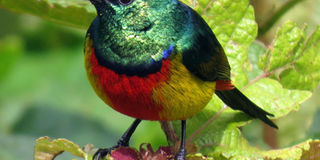Celebrating Uganda’s birds

The Regal sun bird
What you need to know:
For the birds. Birders in Uganda gather today to celebrate the Birding Big Day and revel in sights of our wondrous winged creatures.
Birds, like the garbage guzzling Marabou Stork and the Shoebill, whose large shoe-like beak assembles tourists at Masamba swamp, Semuliki River and Murchison Falls are a marvel.
This year’s week-long celebration of birds and animal life is under the patronage of Uganda Tourism Board and Uganda World Life Authority.
The activities
Johnnie Kamugisha, the president of the Uganda Bird Guides Club, says the birders shall be bird-watching for 24 hours and stop immediately before midnight.
A host of international birders; Dominic Mitchell, the managing editor of Bird Watch, Europe’s leading monthly magazine for keen birders, Tim Appleton, the co-founder/ organiser of the British Birding Fair, Bill Thompson, the editor Bird Watcher’s Digest and director of the Ohio Ornithologist Society, have been invited to increase worldwide coverage for Uganda as a tourism destination. These renowned birders will boost the event while they update information and pictures of their experience here.
Kamugisha effortlessly names each bird; identifying their habitats and unique features. He lightly whistles the call of the Red Chest Bubbet, enthusiastically arguing that once the bird hears the sound, it will come to see whoever is in its territory. He says he ably talks to them and maintains calm so as to call them back incase they fly away.
He identifies the Freckled Nightjar that camouflages with grey rock, the very rare yet endangered shoebill, which inhabits swamps in Mabamba, Nabajuzi, Masaka, south of Lake Albert and between Lira- Soroti districts.
“I started birding as a young boy, yet I did not know that was what I was doing then. Whenever I left Kampala to go the village for Christmas, I would spend time in the bushes searching for birds,” the passionate Kamugisha speaks about his birding experience.
He started birding around 1999, and got into trouble with residents and the police who never understood what he and his colleagues were doing. Folks mistook binoculars and telescopes for riffles. Birding Big Day will therefore inform people about birds and conservation.
“It is important to let in people at a young age. They grow up in the culture of bird-watching, which is big business in America which has millions of bird watchers,” he retorts.
This whole birding culture might seem quite new to the everyday Ugandan, but the Birding Big Week launched on November 26 at Kasenge Forest Resort, Mukono, runs until December 6. It will create awareness about birds, establish how many species are in Uganda, but also market the Pearl of Africa as a landmark tourism destination for bird watching and study.
There is no particular requirement to join birders. One simply needs to have interest in birds. Species identification grows to different levels with time; you gradually learn different bird calls, sounds and traits.
Challenges
Judith Mirembe, the Head of Uganda Women Birders Association, says the nearly 30 vibrant bird loving members are dependent students or fresh graduates.
They have fears of managing costs aligned with purchasing (often imported) binoculars (these cost up to Shs1.5 million), training fees and transport to different specie locations. Guide books are insufficient and birding not quite popular among Ugandan folk.
Most Ugandans are unformed about birding and there is not enough media coverage even for the Birding Big Day. A concerned Kamugisha suggests that money and marketing are required to invest in bird watching.
Government called upon
“Government ought to inject money because while Kenya and Rwanda put in millions, we inject only $2000(about Shs5 million),” he says. How much recognition could Uganda earn as a whole, if Kamugisha’s sole contribution at the British Birding Fair is commendable?
However, avenues like Young Birders Club, Uganda Women Birders Association, Uganda Safari Guides, and Uganda Bird Guides Club have been formed over the years to nurture birding. You can find a six-year-old who can lead a trip and identify species. “My son, Prince, surprised his mother when he identified the African Grey Parrot,” Kamugisha cheers.
Uganda: the land of birds

Tourists view birds at Masamba swamp in Wakiso District
Gifted Uganda. According to Johnnie Kamugisha, the president of the Uganda Bird Guides Club, Uganda ranks as “the Birders Paradise.” With more than 1,000 bird species, Bwindi Impenetrable Forest is ranked one of the best sites.
“Queen Elizabeth alone has 600 species yet England as a whole has 600-800 bird species only. Uganda’s birds have nice colours and some species are found only in Uganda,” he says.
Scrolling through his photography, he taps on the Green Breasted Pitta, a very tiny bird that one birder had never seen despite her five trips here. “She cried,” he said, as he drew in the brown, white dotted African Fin Foot with an orange beak and feet.
“I am intrigued by the Green Breasted Pitta in Kibaale Forest. It is so rare- you cannot find it anywhere. We had to wake up by 5am to listen to it flap its wings. It has its own distinct sound, so particular from other bird species,” an expressive Judith Mirembe speaks about her favourite bird species, including the Marabou stork, Shoebill and Saddle Billed Stork. She is the Chairperson of the Uganda Women Birders Association which begun in May 2003.
A Birder’s inspiration. Raised under the guardianship of Herbert Byaruhanga, president of Uganda Tourism Association, head of Private Sector Tourism and president of Uganda Safari Guides Association; Mirembe, a finalist of Environmental Science at Makerere University, was inspired by the love for birds, tourism and nature, that she plans to become an Ornithologist (a bird specialist/ Birder).
Advocating for protection of birds’ habitats, she prescribes taming them by planting trees and flowers around a home so they feel like they belong, rather than caging them from natural freedom as pets.
Aim of birds association. Uganda Women Birders Association aims at promoting birding among women and scoring for their contribution to tourism on a wider scale.
To have them venture into the largely male dominated field in regard to Tour Guides, Tour operators, drivers; so that they too impact on tourism and livelihood of their families through available job opportunities in the sector. Despite focus on women, Mirembe says membership is free and open to anyone, and men as relatives or sources of financial support cannot be eliminated.
Task.
Mirembe is tasked to ensure that more women convene for the bird watching that will be in prominent locations like Semiliki, Kidepo National Park and Kasenge. Birders dispatch from the Uganda Museum today to the several locations.
How to join
Where.
To be part of the birding week, one can go to the Uganda Museum at 7am where one can get transport to the different sites or simply go to the sites that include; Entebbe, Makerere University, Bahai Temple, Kasenge Forest Resort and Mabira Forest.




